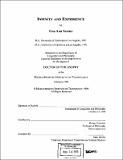Infinity and experience
Author(s)
Sereno, Lisa Ann, 1967-
DownloadFull printable version (8.256Mb)
Advisor
Robert Stalnaker.
Terms of use
Metadata
Show full item recordAbstract
This dissertation explores the relationship between our experience and knowledge of the infinite. The first chapter is a critical examination of Shaughan Lavine's project in Understanding the Infinite. Lavine argues that although we do not experience the infinite, we can explain how we acquire knowledge of the infinite by appeal to our experience of the indefinitely large. I argue that Lavine's proposal fails. In the second chapter I argue that, contrary to what Lavine and others have claimed, we can have "experiences of the infinite." In particular, I argue that we can have a perceptual illusion of an infinite sequence when we see certain pictures. In the third chapter, I argue that the experiences of the infinite discussed in the second chapter help us defend a central tenet of modal structuralism, namely the claim that there could exist infinitely many objects. In order to show that we have evidence for this modal claim, I explain how, in general, we can use pictures to establish that the depicted object could exist. I argue that upon seeing a picture, we can obtain evidence that a picture represents a "coherent" rather than an "incoherent" spatial configuration, and furthermore, that if we obtain evidence that a picture represents a coherent spatial configuration, we thereby obtain evidence that the depicted object could exist. I then use this "picture method" to show that by seeing a picture of an infinite sequence, we can obtain evidence for the modal claim that an infinite sequence could exist.
Description
Thesis (Ph.D.)--Massachusetts Institute of Technology, Dept. of Linguistics and Philosophy, February 1999. Includes bibliographical references (p. 145-146).
Date issued
1999Department
Massachusetts Institute of Technology. Department of Linguistics and PhilosophyPublisher
Massachusetts Institute of Technology
Keywords
Linguistics and Philosophy
